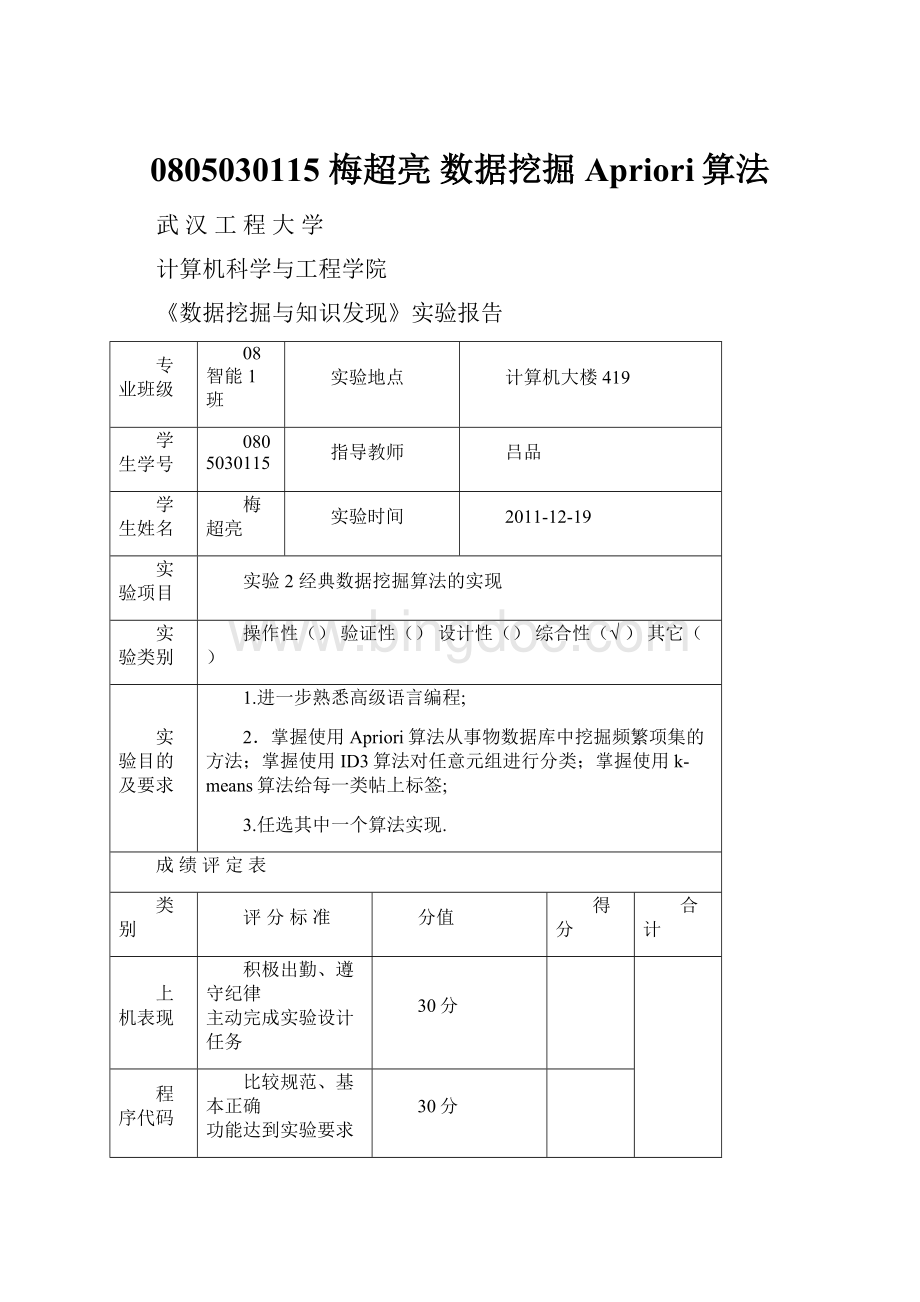0805030115 梅超亮 数据挖掘 Apriori算法.docx
《0805030115 梅超亮 数据挖掘 Apriori算法.docx》由会员分享,可在线阅读,更多相关《0805030115 梅超亮 数据挖掘 Apriori算法.docx(15页珍藏版)》请在冰点文库上搜索。

0805030115梅超亮数据挖掘Apriori算法
武汉工程大学
计算机科学与工程学院
《数据挖掘与知识发现》实验报告
专业班级
08智能1班
实验地点
计算机大楼419
学生学号
0805030115
指导教师
吕品
学生姓名
梅超亮
实验时间
2011-12-19
实验项目
实验2经典数据挖掘算法的实现
实验类别
操作性()验证性()设计性()综合性(√)其它()
实验目的及要求
1.进一步熟悉高级语言编程;
2.掌握使用Apriori算法从事物数据库中挖掘频繁项集的方法;掌握使用ID3算法对任意元组进行分类;掌握使用k-means算法给每一类帖上标签;
3.任选其中一个算法实现.
成绩评定表
类别
评分标准
分值
得分
合计
上机表现
积极出勤、遵守纪律
主动完成实验设计任务
30分
程序代码
比较规范、基本正确
功能达到实验要求
30分
实验报告
及时递交、填写规范
内容完整、体现收获
40分
说明:
评阅教师:
日期:
2011年月日
实验内容
1.算法思想
(1)首先遍历一次数据库,得到所有单元素的
最后的总结果:
2.源程序使用的数据结构
结构体Shop用来记录每个商店所拥有的商品名、该商店名
structShop
{
charTID[5];//商店Id
charGoods[5];//该商店所有的商品名
}AllElectronics[9];
结构体GoodNode记录链表的节点。
每个节点有以下内容:
商品名、该节点的支持度、下一个节点的地址。
structGoodNode
{
charGoods[10];
intsup;
structGoodNode*next;
};
结构体slistGoodV表示的是候选项目集的链表
structslistGoodV
{
structGoodNode*head;
structGoodNode*tail;
intlen;
}TALL;
3.源程序
#include
#include
#include
structShop
{
charTID[5];
charGoods[5];
}AllElectronics[9];
structGoodNode
{
charGoods[10];
intsup;
structGoodNode*next;
};
structslistGoodV
{
structGoodNode*head;
structGoodNode*tail;
intlen;
}TALL;
向候选项目集的链表中的尾部插入节点newnode
structGoodNode*AddTail(structGoodNode*newnode)
{
if(TALL.len==0)
{
TALL.head=newnode;
TALL.tail=newnode;
TALL.head->next=NULL;
TALL.tail->next=NULL;
}
else
{
TALL.tail->next=newnode;
TALL.tail->next->next=NULL;
TALL.tail=newnode;
}
TALL.len++;
returnTALL.head;
}
产生第一个链表
voidProduceListA()
{
chartmp[10];
structGoodNode*tem;
structGoodNode*flag,*flag2,*tail;
flag=TALL.head;
tail=TALL.tail;
while(flag!
=tail)
{
flag2=flag->next;
while(flag2!
=tail)
{
memset(tmp,0,10);
strcpy(tmp,flag->Goods);
strcat(tmp,flag2->Goods);
tem=(structGoodNode*)malloc(sizeof(structGoodNode));
strcpy(tem->Goods,tmp);
tem->sup=0;
AddTail(tem);
flag2=flag2->next;
}
memset(tmp,0,10);
strcpy(tmp,flag->Goods);
strcat(tmp,flag2->Goods);
tem=(structGoodNode*)malloc(sizeof(structGoodNode));
strcpy(tem->Goods,tmp);
tem->sup=0;
AddTail(tem);
flag=flag->next;
}
flag=TALL.head;
while(flag->sup!
=0)
{
TALL.head=TALL.head->next;
free(flag);
flag=TALL.head;
}
}
在前一个链表基础上产生下一个链表
voidProduceListB()
{
chartmp[10];
structGoodNode*tem;
structGoodNode*flag,*flag2,*tail;
flag=TALL.head;
tail=TALL.tail;
while(flag!
=tail)
{
flag2=flag->next;
while(flag2!
=tail)
{
if(flag->Goods[0]!
=flag2->Goods[0])
break;
memset(tmp,0,10);
strcpy(tmp,flag->Goods);
tmp[2]=flag2->Goods[1];
tmp[3]='\0';
tem=(structGoodNode*)malloc(sizeof(structGoodNode));
strcpy(tem->Goods,tmp);
tem->sup=0;
AddTail(tem);
flag2=flag2->next;
}
if(flag->Goods[0]==flag2->Goods[0])
{
memset(tmp,0,10);
strcpy(tmp,flag->Goods);
tmp[2]=flag2->Goods[1];
tmp[3]='\0';
tem=(structGoodNode*)malloc(sizeof(structGoodNode));
strcpy(tem->Goods,tmp);
tem->sup=0;
AddTail(tem);
}
flag=flag->next;
}
flag=TALL.head;
while(flag->sup!
=0)
{
TALL.head=TALL.head->next;
free(flag);
flag=TALL.head;
}
}
判断链表中的节点的商品名是否在某个商店中
intIfInItem(structShop*shop,structGoodNode*node)
{
inti=0;
intk=0;
intflag=0;
while(node->Goods[i]!
='\0')
{
k=0;
flag=0;
while(shop->Goods[k]!
='\0')
{
if(node->Goods[i]==shop->Goods[k])
{
flag=1;
break;
}
k++;
}
if(flag==0)
{
return0;
}
i++;
}
return1;
}
计算链表中每个节点的支持度
voidAddSup()
{
structGoodNode*tmp;
tmp=TALL.head;
inti=0;
intj;
while(tmp!
=NULL)
{
for(j=0;j<9;j++)
{
if(IfInItem(&AllElectronics[j],tmp)==1)
{
tmp->sup++;
}
}
tmp=tmp->next;
}
}
删除链表中的节点
voidDeleteNode(intk)//k为支持度
{
structGoodNode*tmp,*tmp2;
tmp=TALL.head;
while(tmp->next!
=NULL)
{
if(tmp->next->sup{
tmp2=tmp->next;
tmp->next=tmp2->next;
free(tmp2);
}
else
tmp=tmp->next;
TALL.len--;
}
if(TALL.head->sup{
tmp=TALL.head;
TALL.head=TALL.head->next;
free(tmp);
TALL.len--;
}
}
boolJudgeSame(char*temp)
{
structGoodNode*tmp;
tmp=TALL.head;
while(tmp!
=NULL)
{
while(strcmp(tmp->Goods,temp)==0)
{
tmp->sup++;
returntrue;
}
tmp=tmp->next;
}
returnfalse;
}
打印链表
voidProduceList()
{
inti;
intj;
intk=0;
chartmp[10];
structGoodNode*tem;
for(i=0;i<9;i++)
{
for(j=0;j<4;j++)
{
memset(tmp,0,10);
k=0;
if(AllElectronics[i].Goods[j]=='\0')
break;
tmp[k++]=AllElectronics[i].Goods[j];
tmp[k++]='\0';
if(JudgeSame(tmp)==true)
continue;
tem=(structGoodNode*)malloc(sizeof(structGoodNode));
strcpy(tem->Goods,tmp);
tem->sup=0;
AddTail(tem);
}
}
}
voidprintTall()
{
structGoodNode*tmp;
tmp=TALL.head;
while(tmp!
=NULL)
{
printf("%s\t%d\n",tmp->Goods,tmp->sup);
tmp=tmp->next;
}
}
初始化商店的商品信息
voidInitShop()
{
strcpy(AllElectronics[0].TID,"T100");
strcpy(AllElectronics[0].Goods,"ABE");
strcpy(AllElectronics[1].TID,"T200");
strcpy(AllElectronics[1].Goods,"BD");
strcpy(AllElectronics[2].TID,"T300");
strcpy(AllElectronics[2].Goods,"BC");
strcpy(AllElectronics[3].TID,"T400");
strcpy(AllElectronics[3].Goods,"ABD");
strcpy(AllElectronics[4].TID,"T500");
strcpy(AllElectronics[4].Goods,"AC");
strcpy(AllElectronics[5].TID,"T600");
strcpy(AllElectronics[5].Goods,"BC");
strcpy(AllElectronics[6].TID,"T700");
strcpy(AllElectronics[6].Goods,"AC");
strcpy(AllElectronics[7].TID,"T800");
strcpy(AllElectronics[7].Goods,"ABCE");
strcpy(AllElectronics[8].TID,"T900");
strcpy(AllElectronics[8].Goods,"ABC");
}
intmain()
{
TALL.head=NULL;
TALL.tail=NULL;
TALL.len=0;
InitShop();
inti,j=0;
printf("商店信息\n");
printf("商店名\t商品\n");
for(i=0;i<9;i++)
{
printf("%s\t",AllElectronics[i].TID);
printf("%s\t",AllElectronics[i].Goods);
printf("\n");
}
printf("第一次产生频繁项集\n");
printf("项集\t支持度\n");
ProduceList();
printTall();
printf("剔除支持度小于\n");
DeleteNode
(2);
printTall();
printf("第二次产生频繁项集\n");
printf("项集\t支持度\n");
ProduceListA();
AddSup();
printTall();
printf("第三次产生频繁项集\n");
printf("项集\t支持度\n");
ProduceListB();
AddSup();
printTall();
return0;
}
实验总结
在这次实验中的难点是:
关联规则挖掘的第二阶段——产生关联规则(AssociationRules)。
从高频项目组产生关联规则,是利用前一步骤的高频k-项目组来产生规则,在最小信赖度(MinimumConfidence)的条件门槛下,经由高频k-项目组{A,B}所产生的规则AB,其信赖度可经由公式求得,若数据结构设置的不好,后面的计算量将不是局部的改变,而是伴随后面所有的候选项目集。
所以我的想法是纵方向设置一个项目集链表,横方向是字符串型的数组。
后面的项目集有前一个的候选项目集产生,所以链表会不断变化,最后就得出了大项目集。
这次实验花费了很长时间,也学到了很多知识,很感谢吕品老师的悉心指导和同学们的热情帮助,让我按时完成了这次实验。